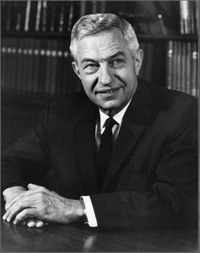Lee A. DuBridge (1901-1994) was an American physicist and administrator and the founding director of the Radiation Laboratory at MIT.
DuBridge was born on September 21, 1901 in Terre Haute, Indiana. After receiving a Ph.D. in Physics from the University of Wisconsin-Madison in 1926, DuBridge taught physics at Washington University in St. Louis and at the University of Rochester. At the urging of Ernest O. Lawrence, he supervised the construction of a cyclotron at Rochester that generated (at that time) the world’s highest energy proton beam.
In 1940, DuBridge was appointed director of the Radiation Laboratory at MIT. During World War II the “Rad Lab,” as it was commonly known, advanced and accelerated radar development. Under DuBridge’s leadership, the Rad Lab became the largest war research laboratory, with an annual budget of $13 million, more than 4,000 staff, and industrial contracts worth $1.5 billion. While not officially part of the Manhattan Project, DuBridge was asked by J. Robert Oppenheimer to troubleshoot issues at Los Alamos because of his experience with the Rad Lab.
After the war, he was named President of Caltech, a position he held for 23 years. DuBridge also served as a member of the U.S. Atomic Energy Commission’s General Advisory Committee and was a scientific advisor to Presidents Truman, Eisenhower, and Nixon. During the McCarthy era, he championed academic freedom, refusing to fire Nobel Prize-winning Caltech professor Linus Pauling over his opposition to nuclear testing.
For his achievements as a scientist and administrator, DuBridge received the Vannevar Bush Award from the National Science Foundation in 1982. He died of pneumonia in Duarte, California on January 23, 1994.





